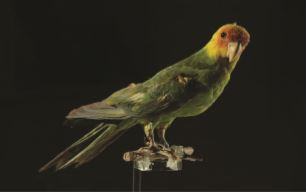
RESEARCHERS from the Institute of Evolutionary Biology (IBE, a joint institute of the Pompeu Fabra University (UPF) and the Spanish National Research Council (CSIC)) in Barcelona and the Globe Institute at the University of Copenhagen have unveiled the genome of the Carolina parakeet, declared extinct at the beginning of the 20th century.
Researchers explored the genome for signs found in endangered species but did not find them, suggesting that Carolina parakeet extinction was an abrupt process and thus solely
attributable to human causes.
The Carolina parakeet (Conuropsis carolinensis) is an iconic North American bird declared extinct at the beginning of the 20th century, after the death of the last specimen at the Cincinnati zoo in 1918.
It was the member of the parrot family to live in the highest northern latitude of the planet, and was distributed from southern New England to the Gulf of Mexico, and all the way to eastern Colorado. It had a striking colour pattern: green in the body, yellow on its head and orange on its face.
Despite flying in noisy flocks of hundreds of individuals, it was extensively hunted during the last decades of the nineteenth century, in part for obtaining its feathers to decorate hats. Still, the cause of its extinction remains contentious: although its excessive mortality could well be associated to its recent habitat destruction and active hunting, its survival could also been negatively affected by its range having become increasingly patchy or by the exposure to poultry pathogens.
Article originally published in: https://thepetridish.my/2019/12/27/carolina-parakeet-extinction/